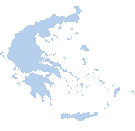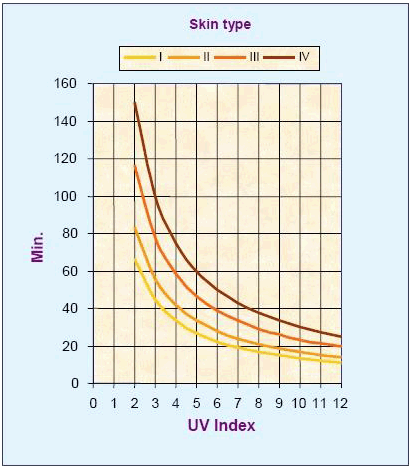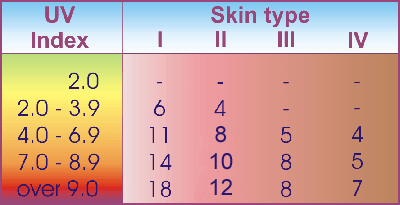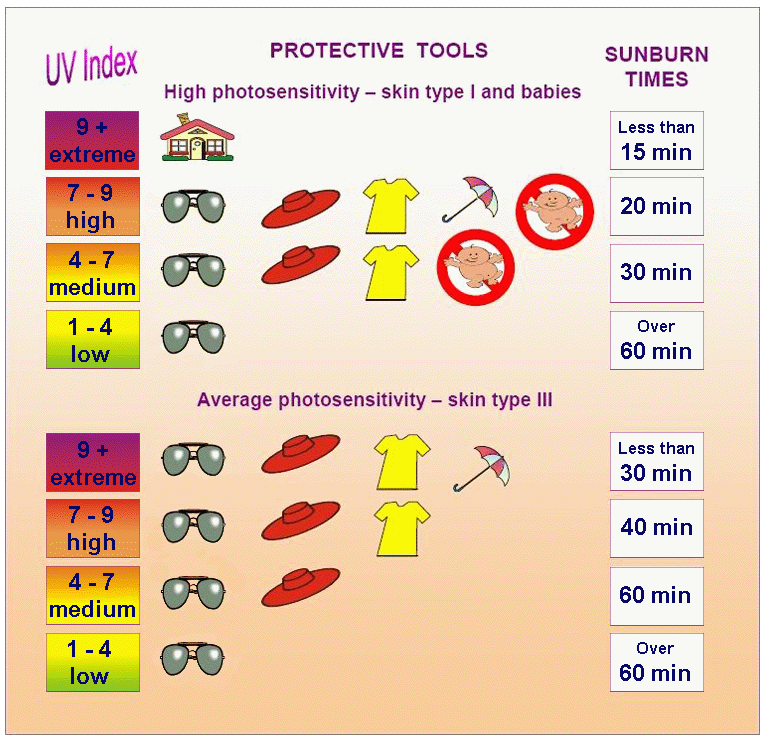About the UV index
(part 2)
|
The harmful effects of UV radiation depend not only on the received UV dose but also on the sensitivity of the individual. Human skin is often classified into four main groups according to the skin’s ability to tan. This classification is shown in the table below which also gives the approximate dose (in J/m2) required to obtain a reddening of the skin (1MED). Thus (1MED) varies for different skin types.
The skin and the eyes are the organs with the highest exposure to the sun’s ultraviolet rays. Although hair and nails are well exposed they are less important from a medical point of view. Exposure to solar UV radiation may result in acute and chronic health effects to the skin, the eyes and to the immune system. Acute effects of UV exposure include erythema (sunburn) of the skin and photokeratitis (welder’s flash, snowblindness) of the eye. Chronic skin effects are skin cancer and premature ageing of the skin while chronic effects to the eye include cataract, pterygium and droplet keratopathy. While UV-B radiation mainly cause erythema and various skin cancers UV-A radiation has a pronounced effect on the subcutaneous tissue and can alter the structure of collagen and elastin fibres and hence accelerate ageing of the skin. It is important to understand that the skin has some capacity to adapt to UV radiation by producing melanin (tan) that protects against UV exposure. The human eye does not have such a capacity.
The sunburn time is the maximum time to stay unprotected in the sun without receiving a sunburn. Sunburn times can be calculated for each skin type from the UV Index and the value of (1MED) for each skin type. As an example, the Table below shows the sunburn times in minutes for different UV Index values and (MEDs) defined by DIN-5050 (shown in Table above). It is important to point out that the value of (1MED) is not a precisely determined number for each skin type. Dermatological studies have shown that within one of the skin types the value of (1MED) may differ depending on the disposition of individuals. To further describe this phenomenon sophisticated regional studies of the photosensitivity of populations are needed.
|
|
The skin is best protected by clothes. A shirt, a hat and trousers offer the best protection. UV-transparent clothes ought to be marked clearly. Skin parts that are not protected by clothes should be protected with a sunscreen containing UV-B and UV-A filters. During the first exposures to the sun a sunscreen with a Sun Protection Factor (SPF) of about 15 is recommended, while it should be at least 20 for children. Particular care should be exercised with babies and small children. Note that the protective effect of sunscreens depend not only on the quality of the sunscreen but also on a correct application of the sunscreen. Most people apply too little. For an adult body the correct amount of sunscreen is about 30-40 g (a good handful) in order to obtain the effect of the sunscreen’s stated (SPF). It should be applied well before exposure to the sun and it should be reapplied after a swim. If sunscreens are properly used they can protect from sunburn, skin cancer and skin ageing. The Sun Protection Factor stated on sunscreens indicate how much longer you can stay in the sun without having a sunburn compared to your personal sunburn time. For example, if your personal sunburn time is 30 minutes and you then apply a sunscreen with a (SPF) of 8 you can stay 8 times longer in the sun, i.e., 4 hours, without having a sunburn. It is important to note that applying the same sunscreen several times in succession does not prolong the “safe” time. There is no additional protection, and the only way to get extra protection is to apply a sunscreen with a higher (SPF). Also, the sunscreen you apply does not help you the next day – the protection is offered only for the day when the sunscreen is applied. Sunscreens with (SPF) of more than 30 actually do not make sense and are mainly produced of marketing advantages.
The eyes can be protected by sunglasses containing UV-B and UV-A filters. A type of filter must be indicated by the producer. Sunglasses with UV-B and UV-A filters are especially important for children because the transmittance of UV radiation through the eye is higher for children than for adults. A child’s retina is less protected. The rationale is that sunglasses without UV protecting filters should not be used.
|
















